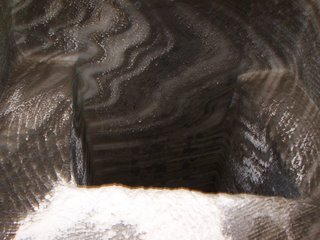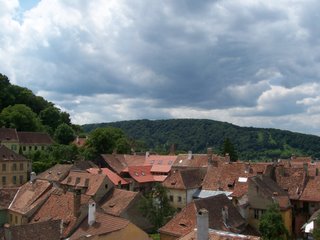Sighisoara
Sighisoara (Sigi-shwara) is a town in Transylvania about 3 hours south of Cluj, and it has a very well preserved medieval quarter. It is also the birthplace of Vlad Tepes (Tepesh) or Vlad the Impaler. Vlad Tepes was a prince of Wallahia in the middle ages, and he became a hero of Romanian nationalism because he stood up to the Turks (Wallahia was a tributary state to the Ottoman Empire at the time). He earned the nickname ‘the impaler’ because of the vast number of Turkish soldiers he impaled. However, the real reason that Vlad Tepes is interesting to Westerners is the fact that he was the historical inspiration for Bram Stoker’s Dracula.
We left for Sighisoara by bus at 8:30 a.m, and on the way there we visited a salt mine. The mine is in a town called Turda, which is rather interesting in and of itself. We went on a tour of the salt mine, which was opened in the mid-1800s. It had been inactive since the 1930s when it became unprofitable because of the depression, but for a while it was used to store cheese because it acts as a natural refrigerator. The salt mine was very cool, because the caverns were enormous, and the walls were made entirely of salt. Our tour guide dropped a rock into one of the caverns in order to show us how deep it was, and it took ages for the rock to hit the bottom. It was amazing.

A look down into the cavern

A wall made of salt
After we left the salt mine, we still had about two and a half hours to go before Sighisoara, but the view of the countryside was very nice. When we arrived in Sighisaora, we went to lunch at a restaurant that is located in the house where Vlad Tepes was born. It serves traditional Romanian cuisine, and I ordered stuffed cabbage and mamaliga. The stuffed cabbage was just like the dish that my Great Aunt Mary served when we visited her and Uncle Alex in Edmonton, Alberta. Having eaten that dish before made me feel very Romanian, which was kind of cool.

A plaque stating that this was the home of Vlad Dracul (Vlad Tepes's father)
After lunch we went up into the clock tower for a panoramic view of the town. The view was very cool, and all around the tower there were little plaques telling visitors how far various cities around the world are from Sighisoara. After descending from the tower, I climbed up the stairs to visit the Church on the Hill and the graveyard that is near it. The church is beautiful, but pictures were not allowed. Luckily I was able to sneak a few for you.

A view of Sighisoara from above

More rooftops of Sighisoara

For Adam and Emily

The alter of the Church on the Hill

The graveyard near the church
The rest of Sighisoara consisted of souvenir shops with a mix Dracula knick-knacks and traditional Romanian art and handiworks. I fell in love with a handmade, traditional Romanian blouse. It is absolutely gorgeous. It was rather expensive, so I debated whether or not I should buy it. But in the end I decided to go for it, and I’m very glad that I did. I learned from some of the Romanian students that the blouse I bought is called an ‘ie’ and that it is woven out of hemp. Sylvia told me that she has one very similar to mine, but it is 200 years old and was passed down by her great-grandmother.

A close up of some of the lace on my 'ie'
We left for Sighisoara by bus at 8:30 a.m, and on the way there we visited a salt mine. The mine is in a town called Turda, which is rather interesting in and of itself. We went on a tour of the salt mine, which was opened in the mid-1800s. It had been inactive since the 1930s when it became unprofitable because of the depression, but for a while it was used to store cheese because it acts as a natural refrigerator. The salt mine was very cool, because the caverns were enormous, and the walls were made entirely of salt. Our tour guide dropped a rock into one of the caverns in order to show us how deep it was, and it took ages for the rock to hit the bottom. It was amazing.

A look down into the cavern

A wall made of salt
After we left the salt mine, we still had about two and a half hours to go before Sighisoara, but the view of the countryside was very nice. When we arrived in Sighisaora, we went to lunch at a restaurant that is located in the house where Vlad Tepes was born. It serves traditional Romanian cuisine, and I ordered stuffed cabbage and mamaliga. The stuffed cabbage was just like the dish that my Great Aunt Mary served when we visited her and Uncle Alex in Edmonton, Alberta. Having eaten that dish before made me feel very Romanian, which was kind of cool.

A plaque stating that this was the home of Vlad Dracul (Vlad Tepes's father)
After lunch we went up into the clock tower for a panoramic view of the town. The view was very cool, and all around the tower there were little plaques telling visitors how far various cities around the world are from Sighisoara. After descending from the tower, I climbed up the stairs to visit the Church on the Hill and the graveyard that is near it. The church is beautiful, but pictures were not allowed. Luckily I was able to sneak a few for you.

A view of Sighisoara from above

More rooftops of Sighisoara

For Adam and Emily

The alter of the Church on the Hill

The graveyard near the church
The rest of Sighisoara consisted of souvenir shops with a mix Dracula knick-knacks and traditional Romanian art and handiworks. I fell in love with a handmade, traditional Romanian blouse. It is absolutely gorgeous. It was rather expensive, so I debated whether or not I should buy it. But in the end I decided to go for it, and I’m very glad that I did. I learned from some of the Romanian students that the blouse I bought is called an ‘ie’ and that it is woven out of hemp. Sylvia told me that she has one very similar to mine, but it is 200 years old and was passed down by her great-grandmother.

A close up of some of the lace on my 'ie'

0 Comments:
Post a Comment
<< Home